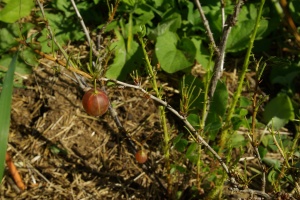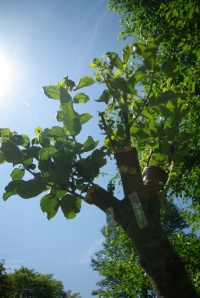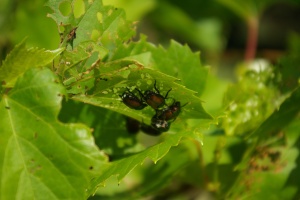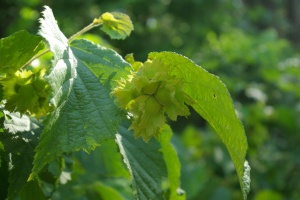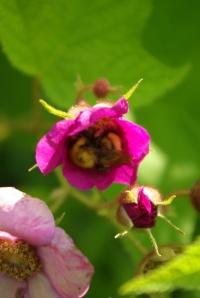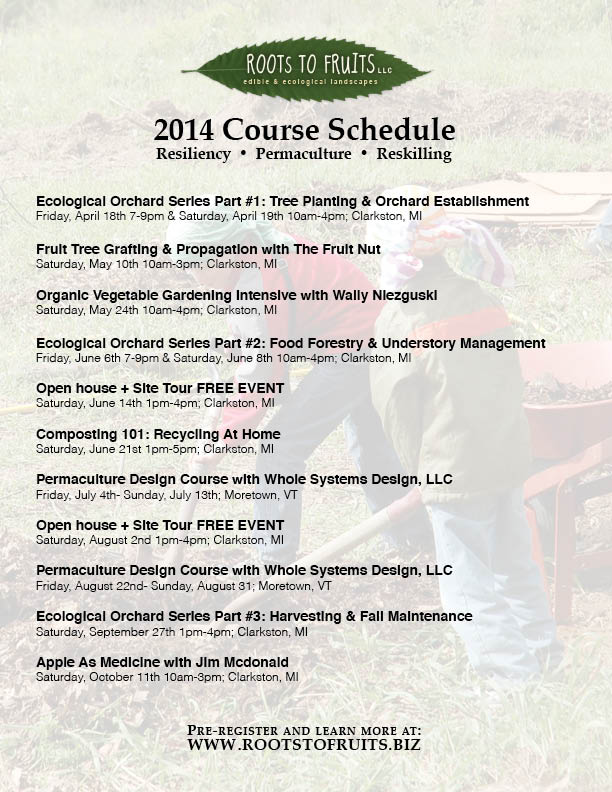I’ve finally gotten around to posting the Roots To Fruits 2014 schedule of events! We are psyched to be offering many exciting classes and workshops in the coming year. More information for each event will be posted to the RTF website soon. Stay posted for registration details…
Tag: grafting
Heeling-In Fruit Trees & Staking Grafts
Autumn is the ideal time to plant bare-root fruit trees. Once your trees have arrived from the nursery its best to get them in the ground ASAP. Sometimes this isn’t possible; this is when ‘heeling-in’ comes handy. Heeling-in is a technique used to store bare-root fruit trees temporarily until they’re ready to be planted. Its a simple procedure which basically entails digging a trench large enough to accommodate the roots of the tree, then placing the roots in the trench so the tree is almost laying on the ground, at about a 90 degree angle parallel to the ground. Fill in the hole with soil so the roots are entirely covered.


Its best to do this in a shadier spot to prevent drying out. Bare-root trees are incredibly sensitive to drying out and they need to be treated with care. Don’t wait too long to heel in your trees if you’re not ready to plant them right away. Trees should generally not stay heeled-in for more then a month or two. With that being said I have managed to forget about heeled-in trees only to find them a season later well rooted with new growth. Don’t do this. Most of the time, however, I heel-in trees for a 1-2 week period until planting day.
One of the most exciting and interesting parts about gardening is you’re always learning something new. Each season new lessons are learned and knowledge is further refined. Its a never-ending learning process. As the garden grows so does the gardeners wisdom. This is experiential knowledge and distinguishes really knowing something versus just thinking something to be true. This year I learned something valuable about topworking trees. ‘Topworking’ refers to grafting high up in mature trees. This may be to switch over a variety or to add more varieties to a tree. I did a lot of apple tree topworking last spring. When grafting onto mature roots first year graft growth can be astonishing…and sometimes too vigorous. I’ve seen apple grafts grow 4+ feet in one season, same for persimmon and chestnut. That can be a big burden for a barely-healed graft union. While walking around the chestnut orchard at Nash Nursery a couple weeks ago I found a clever system they’d devised for staking 1st year grafts. This video shows that system:
Seeing these staked grafted was an Ah Ha! moment for me…thinking back to those apple trees I’d topworked last spring I’d realized this is what they needed. Just a couple days ago when walking through the orchard I came across one of the most successful topworking jobs from last spring…only to find one of the grafts had snapped off! Needed those stakes…

Staking is good not only for providing structural support but also for directional training. From what I’ve seen these grafts want to grow vertically…staking them at desired angles and directions could be beneficial.
Berries, berries, and more berries!
The heat of summer is in full swing, and the berry season is starting to pick up. With such a strange winter and spring the ripening times aren’t ‘normal’, or more accurately aren’t as they’ve been in years past. With that being said, tis the season for berry picking! Take it when it comes and do your darndest to best utilize mother nature’s abundance of nourishing and tasteful summer fruits! I’ve been doing just that…
Several days ago on a bike ride with my friend Paris Rae, we came upon a lovely patch of Ribes odoratum, or clove currant. This is a black currant species indigenous to NA with large, shiny black berries that are highly aromatic with a wonderful spicey-sweet flavor. A truly delectable roadside find!
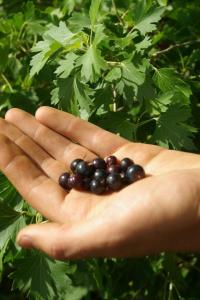
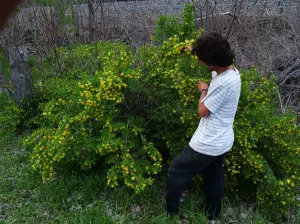
For the past 3-4 weeks I’ve been consuming plenty of European black currants (Ribes nigrum) of which I absolutely indulge upon and relish their complex ‘foxy’ flavor! Five varieties grow in my garden which all ripen at slightly different times, and today I picked the last of ’em from ‘Consort’. The bushes hold onto to their fruit quite well for the duration of picking season, which is a nice characteristic. This cannot be said for softer fruits like raspberries. I was meaning to make a batch of black currant jelly, but instead ended up eating them all fresh out of hand and mixed in salads. I love to let visitors try the black currants and observe their reaction. Most people enjoy them.
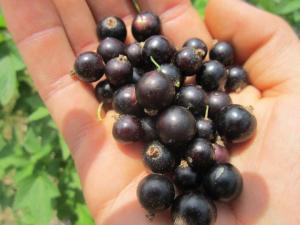
On hot days like today I like to make a refreshing iced berry drink. Today I made one with black currants. It is a simple recipe and you can alternate black currants with any other berry. This is all you’ll need:
- 1 cup fresh berries
- 1 cup crushed ice
- A spoonful of organic raw honey never hurts
I use a magic bullet with the heavy duty blade; you can use a blender, vita-mix, or whatever you’ve got! Mix the ingredients and blend. Sometimes you’ll need to add a small amount of water or other liquid to get the blending started.
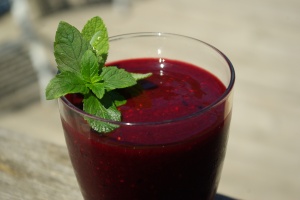
Blackcaps, or black raspberries, are reaching their peak season. They happily grow wild around here and if you know a good spot then there is usually never a shortage of berries. I like to freeze them for use in pies and smoothies during winter. They also make a delicious low-sugar jam.
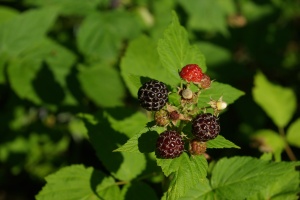
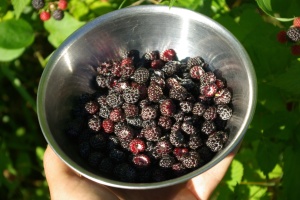
I expect the next two weeks to be the ideal time to collect a lot of these gems for freezing and preserving. Once you familiarize yourself with these fruits you’ll learn that its all about timing and it surely pays to keep a close eye on whose ripening!
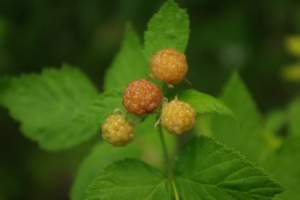
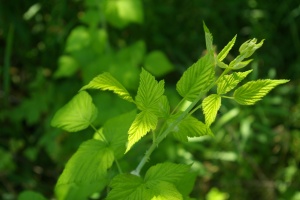
In my garden it is an ‘in-between’ year for strawberries. My strawberry bed was renovated this spring so it won’t be in production again until next year. Fortunately I have a lot of alpine strawberries still producing. Alpine strawberries are the wild european strawberry. Similar to the woodland strawberries you find growing here. Small fruit that packs a serious punch. Red and white-fruited varieties exist and their everbearing tendency keeps fresh berries comin’ all season! The ones in the image below were picked from a local edible landscape installed by Roots To Fruits. Stay tuned for a coming article on alpine strawberries
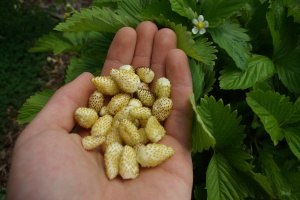
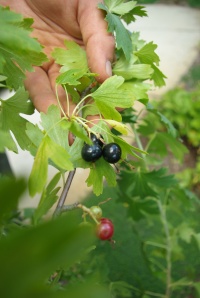
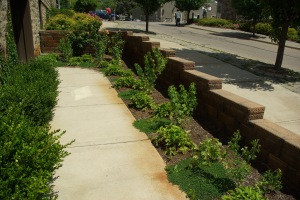
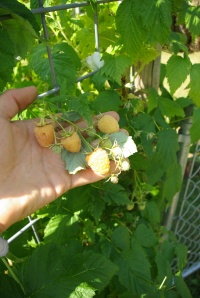
One of the nice things about white-fruited berries vs. red,purple/blue hues is that they appear to be less noticeable to birds. Birds tend to recognize red and purple as something to go for where white and yellow, from my experience- are left alone. White alpine strawberries and golden raspberries are great from that regard. Another nice white-fruited berry is white currant. Technically white currants are just a variant of red currant (R.rubrum). I have a few varieties in my garden and most of them are all gone by now as they ripen much faster then reds(which are just starting to ripen). However a later ripening variety by the name of ‘Primus’ lives in my garden, and she is just now starting to ripen her berries(no currants are not dioecious!).
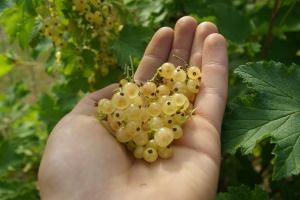
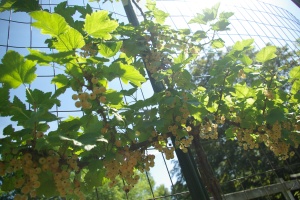
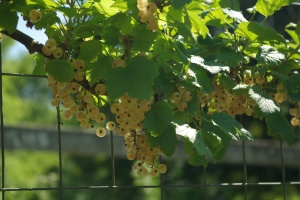
It has been a sad season for my gooseberries. I set out nearly 15 new bushes this year and they’ve had a rough go thus far. But its mainly my fault. They were planted in an area where horses and deer live and apparently the fencing system was not adequate. Aside from being trampled on a few times, there’s also been a serious outbreak of small green worms which defoliate a plant in a number of days. Not sawfly, still needs ID. If anyone knows please share.
